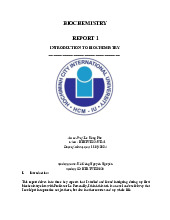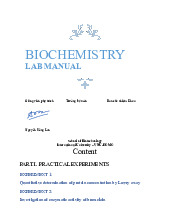

Preview text:
lOMoAR cPSD| 36490632
7)What is metabolism and why do you need to study it? Based on your best understanding of
metabolism, summarize the key notes related to its basic roles and functions of metabolism in the living organisms.
-The metabolism of a person is more than simply one thing. It's the process through which your body
stores and turns the meals you eat into the energy you need to be alive and active. Learning more
about your individual metabolism and how your body uses energy may help you make better dietary
choices and get more exercise on a regular basis.
-The basic role of metabolism is to generate energy for living organisms and the four major roles of
metabolism in a biological organism are as follows:
1) The conversion of light energy into chemical energy (photosynthesis) and the subsequent use of
thatenergy (homeostasis, growth, physical work etc.).
2) Transform biomolecules (stored chemical energy) into one's own molecules.
3)Polymerize these molecules to create starch, glycogen, proteins, nucleic acid, and other materials
for storage and other purposes.
4)Depending on the body's needs, synthesize or breakdown these molecules into specialized
molecules such as antibodies or glycoproteins.
8) What do you know about glycolysis, focus on structure of intermediates as well as enzymes, NADHs and ATPs.
Glycolysis, that literally means "sugar breakdown," is a catabolic process that involves the oxidation
and breakdown of six-carbon sugars (hexoses) into pyruvate molecules. Gluconeogenesis is the name
given to the anabolic process that produces glucose. Both glycolysis and gluconeogenesis are not large
oxidative/reductive processes in and of themselves, with just one step involving electron loss/gain in
each, although glycolysis' result, pyruvate, may be totally oxidized to carbon dioxide.
Glycolysis occurs in a cell's cytoplasm and is divided into two phases: the energy-demanding phase
(above the dotted line in the figure below) and the energy-releasing phase (below the dotted line).
Phase that requires a lot of energy. The initial molecule of glucose is rearranged and two phosphate
groups are linked to it in this step. The phosphate groups make fructose-1,6-bisphosphate unstable,
allowing it to break in half and generate two phosphate-bearing three-carbon sugars. Because the
phosphates utilized in these procedures are derived from ATP molecules, they are quickly depleted.
In glycolysis, each process is catalyzed by its own enzyme. Phosphofructokinase, which catalyzes the
synthesis of the unstable two-phosphate sugar molecule fructose-1,6-bisphosphate, is the most
critical enzyme for glycolysis control. In reaction to the cell's energy demands, phosphofructokinase
speeds up or slows down glycolysis.
In all, glycolysis turns one six-carbon glucose molecule into two three-carbon pyruvate molecules. Two
molecules of ATP (4ATP created - 2ATP used up) and two molecules of NADH are the net results of this
operation. 9) Discuss and exemplify the differences between anabolism and Catabolism, lOMoAR cPSD| 36490632 where possible.
Catabolism is a term used to describe a set of metabolic processes catalyzes the breakdown of
polysaccharides into smaller molecules or monomers. Complex compounds are broken down into
smaller molecules that can be used as construction blocks for other compounds needed by cells, such
as glycogen, proteins, and triglycerides.
Anabolism is a series of enzyme-catalyzed processes in which nutrients are utilized to make relatively
complex molecules. Biosynthesis is a term used to describe the process of anabolism. The process
involves the creation of cell components such as proteins, carbohydrates, and lipids. Catabolic
reactions are controlled by anabolic processes in developing cells. In non-growing cells, there is a balance between the two.
Difference Between Catabolism and Anabolism Catabolism Anabolism
Catabolism is the breakdown of large, complex compound
Anabolism is the process of constructing m s into smaller, more absorbable ones.
olecules that are essential for the body's pr oper functioning.
Catabolism is a metabolic process that releases energy.Energy is required for anabolic processes. Adrenaline, cytokine, glucagon,
and cortisol are hormones Estrogen, testosterone, growth hormones, that are involved in the processes. and insulin are all
involved in the process. Proteins decompose into amino acids, glycogen decompos
Polypeptides are made from amino acids,
g es into glucose, and triglycerides decompose into fatty aci
lycogen is made from glucose, and triglyce ds are all examples of
catabolic processes. rides are made from fatty acids.
Potential energy is converted to kinetic energy durin
Kinetic energy is turned into potential ener g catabolism. gy during anabolism.
It is necessary for living beings to carry out a variety of ta
It's necessary for upkeep, growth, and stor sks. age.
Document Outline
- Catabolism Anabolism




